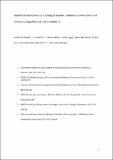Files in this item
Automated detection and tracking of marine mammals : a novel sonar tool for monitoring effects of marine industry
Item metadata
| dc.contributor.author | Hastie, Gordon Drummond | |
| dc.contributor.author | Wu, Gi-Mick | |
| dc.contributor.author | Moss, Simon | |
| dc.contributor.author | Jepp, Pauline | |
| dc.contributor.author | MacAulay, Jamie Donald John | |
| dc.contributor.author | Lee, Arthur | |
| dc.contributor.author | Sparling, Carol Elizabeth | |
| dc.contributor.author | Evers, Clair Hilary Marie | |
| dc.contributor.author | Gillespie, Douglas Michael | |
| dc.date.accessioned | 2020-09-05T23:34:44Z | |
| dc.date.available | 2020-09-05T23:34:44Z | |
| dc.date.issued | 2019-09-06 | |
| dc.identifier | 257875167 | |
| dc.identifier | 24304526-7341-4ede-9a28-a320de88f03b | |
| dc.identifier | 85071749374 | |
| dc.identifier | 000484997200009 | |
| dc.identifier.citation | Hastie , G D , Wu , G-M , Moss , S , Jepp , P , MacAulay , J D J , Lee , A , Sparling , C E , Evers , C H M & Gillespie , D M 2019 , ' Automated detection and tracking of marine mammals : a novel sonar tool for monitoring effects of marine industry ' , Aquatic Conservation: Marine and Freshwater Ecosystems , vol. 29 , no. S1 , pp. 119-130 . https://doi.org/10.1002/aqc.3103 | en |
| dc.identifier.issn | 1052-7613 | |
| dc.identifier.other | ORCID: /0000-0001-9628-157X/work/61622009 | |
| dc.identifier.other | ORCID: /0000-0002-9773-2755/work/61622216 | |
| dc.identifier.other | ORCID: /0000-0001-7658-5111/work/89178123 | |
| dc.identifier.uri | https://hdl.handle.net/10023/20558 | |
| dc.description | Funding: The work was funded under the Scottish Government Demonstration Strategy (Project no. USA/010/14)and as part of the Department of Energy and Climate Change’s Offshore Energy Strategic Environmental Assessment programme, with additional resources from the Natural Environment Research Council (grant numbers: NE/R014639/1 and SMRU1001). | en |
| dc.description.abstract | 1. Many marine industries may pose acute risks to marine wildlife. For example, tidal turbines have the potential to injure or kill marine mammals through collisions with turbine blades. However, the quantification of collision risk is currently limited by a lack of suitable technologies to collect long‐term data on marine mammal behaviour around tidal turbines. 2. Sonar provides a potential means of tracking marine mammals around tidal turbines. However, its effectiveness for long‐term data collection is hindered by the large data volumes and the need for manual validation of detections. Therefore, the aim here was to develop and test automated classification algorithms for marine mammals in sonar data. 3. Data on the movements of harbour seals were collected in a tidally energetic environment using a high‐frequency multibeam sonar on a custom designed seabed‐mounted platform. The study area was monitored by observers to provide visual validation of seals and other targets detected by the sonar. 4. Sixty‐five confirmed seals and 96 other targets were detected by the sonar. Movement and shape parameters associated with each target were extracted and used to develop a series of classification algorithms. Kernel support vector machines were used to classify targets (seal vs. nonseal) and cross‐validation analyses were carried out to quantify classifier efficiency. 5. The best‐fit kernel support vector machine correctly classified all the confirmed seals but misclassified a small percentage of non‐seal targets (~8%) as seals. Shape and non‐spectral movement parameters were considered to be the most important in achieving successful classification. 6. Results indicate that sonar is an effective method for detecting and tracking seals in tidal environments, and the automated classification approach developed here provides a key tool that could be applied to collecting long‐term behavioural data around anthropogenic activities such as tidal turbines. | |
| dc.format.extent | 2008711 | |
| dc.language.iso | eng | |
| dc.relation.ispartof | Aquatic Conservation: Marine and Freshwater Ecosystems | en |
| dc.subject | Behaviour | en |
| dc.subject | Mammals | en |
| dc.subject | Monitoring | en |
| dc.subject | New techniques | en |
| dc.subject | Ocean | en |
| dc.subject | Renewable energy | en |
| dc.subject | GE Environmental Sciences | en |
| dc.subject | GC Oceanography | en |
| dc.subject | QH301 Biology | en |
| dc.subject | DAS | en |
| dc.subject | SDG 7 - Affordable and Clean Energy | en |
| dc.subject | SDG 14 - Life Below Water | en |
| dc.subject.lcc | GE | en |
| dc.subject.lcc | GC | en |
| dc.subject.lcc | QH301 | en |
| dc.title | Automated detection and tracking of marine mammals : a novel sonar tool for monitoring effects of marine industry | en |
| dc.type | Journal article | en |
| dc.contributor.sponsor | NERC | en |
| dc.contributor.sponsor | NERC | en |
| dc.contributor.institution | University of St Andrews. School of Biology | en |
| dc.contributor.institution | University of St Andrews. Sea Mammal Research Unit | en |
| dc.contributor.institution | University of St Andrews. Scottish Oceans Institute | en |
| dc.contributor.institution | University of St Andrews. Marine Alliance for Science & Technology Scotland | en |
| dc.contributor.institution | University of St Andrews. Bioacoustics group | en |
| dc.contributor.institution | University of St Andrews. Sound Tags Group | en |
| dc.identifier.doi | https://doi.org/10.1002/aqc.3103 | |
| dc.description.status | Peer reviewed | en |
| dc.date.embargoedUntil | 2020-09-06 | |
| dc.identifier.grantnumber | NE/R014639/1 | en |
| dc.identifier.grantnumber | Agreement R8-H12-86 | en |
This item appears in the following Collection(s)
Items in the St Andrews Research Repository are protected by copyright, with all rights reserved, unless otherwise indicated.

